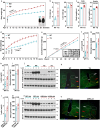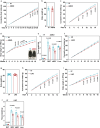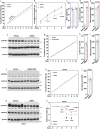This is a preprint.
A brown fat-enriched adipokine, ASRA, is a leptin receptor antagonist that stimulates appetite
- PMID: 37745491
- PMCID: PMC10515849
- DOI: 10.1101/2023.09.12.557454
A brown fat-enriched adipokine, ASRA, is a leptin receptor antagonist that stimulates appetite
Abstract
The endocrine control of food intake remains incompletely understood, and whether the leptin receptor (LepR)-mediated anorexigenic pathway in the hypothalamus is negatively regulated by a humoral factor is unknown. Here, we identify an appetite-stimulating factor - ASRA - that represents a peripheral signal of energy deficit and orthosterically antagonizes LepR signaling. Asra encodes an 8 kD protein that is abundantly and selectively expressed in adipose tissue and to a lesser extent, in liver. ASRA associates with autophagy vesicles and its secretion is enhanced by energy deficiency. In vivo, fasting and cold stimulate Asra expression and increase its protein concentration in cerebrospinal fluid. Asra overexpression attenuates LepR signaling, leading to elevated blood glucose and development of severe hyperphagic obesity. Conversely, either adipose- or liver-specific Asra knockout mice display increased leptin sensitivity, improved glucose homeostasis, reduced food intake, resistance to high-fat diet-induced obesity, and blunted cold-evoked feeding response. Mechanistically, ASRA acts as a high affinity antagonist of LepR. AlphaFold2-multimer prediction and mutational studies suggest that a core segment of ASRA binds to the immunoglobin-like domain of LepR, similar to the 'site 3' recognition of the A-B loop of leptin. While administration of recombinant wild-type ASRA protein promotes food intake and increases blood glucose in a LepR signaling-dependent manner, point mutation within ASRA that disrupts LepR-binding results in a loss of these effects. Our studies reveal a previously unknown endocrine mechanism in appetite regulation and have important implications for our understanding of leptin resistance.
Conflict of interest statement
Competing interests Y.-X.W, L.H., and Y.D. have filed a patent application on ASRA.
Figures






Similar articles
-
Leptin receptor-deficient (knockout) medaka, Oryzias latipes, show chronical up-regulated levels of orexigenic neuropeptides, elevated food intake and stage specific effects on growth and fat allocation.Gen Comp Endocrinol. 2014 Jan 1;195:9-20. Gen Comp Endocrinol. 2014. PMID: 24505600
-
Leptin signaling, adiposity, and energy balance.Ann N Y Acad Sci. 2002 Jun;967:379-88. doi: 10.1111/j.1749-6632.2002.tb04293.x. Ann N Y Acad Sci. 2002. PMID: 12079865 Review.
-
Altered function of arcuate leptin receptor expressing neuropeptide Y neurons depending on energy balance.Mol Metab. 2023 Oct;76:101790. doi: 10.1016/j.molmet.2023.101790. Epub 2023 Aug 9. Mol Metab. 2023. PMID: 37562743 Free PMC article.
-
Disrupted Leptin Signaling in the Lateral Hypothalamus and Ventral Premammillary Nucleus Alters Insulin and Glucagon Secretion and Protects Against Diet-Induced Obesity.Endocrinology. 2016 Jul;157(7):2671-85. doi: 10.1210/en.2015-1998. Epub 2016 May 16. Endocrinology. 2016. PMID: 27183315
-
From feeding one to feeding many: hormone-induced changes in bodyweight homeostasis during pregnancy.J Physiol. 2008 Jan 15;586(2):387-97. doi: 10.1113/jphysiol.2007.146316. Epub 2007 Nov 22. J Physiol. 2008. PMID: 18033810 Free PMC article. Review.
References
Publication types
Grants and funding
LinkOut - more resources
Full Text Sources
Miscellaneous
